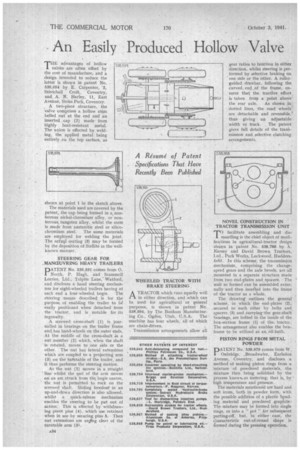An Easily Produced Hollow Valve
Page 44

If you've noticed an error in this article please click here to report it so we can fix it.
TE advantages of hollow valves are often offset by the cost of manufacture, and a design intended to •reduce the latter is shown in patent No, 538,654 by E. Carpenter, -2, Stivichall Croft, Coventry, and A. N. Harley, 11, East Avenue, Stoke Park, Coventry.
A two-piece structure, the valve comprises a hollow stem belled out at the end and an inserted cap (2) made from highly heat-resistant metal. The union is effected by welding, the applied metal being entirely on the top surface, as
shown at point .1 in the sketch above.
The materials used are covered by the patent, the cap being formed in a, nonferrous nickel-chromium alloy, • or nonferrous, tungsten alloy, whilst the stem is made from austenitic steel or silicochromium steel. The same materials are employed for welding the joint. The actuq.1 seating (3) may be formed by the deposition of Stellite in the wellknown manner.
STEERING GEAR FOR ,,MANCEUVRING HEAVY TRAILERS PATENT No. 538,591 comes from 0. North, P. IIugh, and Scainmell Lorries, Ltd., Tolpits Lane:Watford, and discloses a hand steering mechanism for eight-wheeled trailers having at each end a four-wheeled bogie. The steering means described is for tide purpose of enabling the trailer to bi easily positioned when detached from The tractor, and is notable for its ingenuity.
A screwed cross-shaft (1) is Journailed in bearings on the trailer frame and has hand-wheels on the outer ends. At the middle of the cross-shaft as a nut member (2) which, when the shaft is rotated, moves to one side or the other. The nut has lateral extensions which are coupled to a projecting arm (3) on the ttrentable of the trailer, and it thus performs the steering motion.
As the nut (2) moves in a straight line whilst the end of the arm moves on an arc struck from the bogie centre, the nut is permitted to rock on the screwed shaft. Sliding freedom in an up-and-down direction is also allowed, whilst a quick-release Mechanism enables the steering to be put out of action: This is effected by withdrawing pivot pins (4), which •ase retained when in use by securing pins 5. Then nut extensions are swpng clear of the turntable arm (31. , gear ratios to funttion in either direction, whilst steering is performed by selective braking on one side or the other. A toilerguided. drawbar, following the curved, end of the frame, ensures that the tractive effort is taken from a point above the rear axle. As shown in dotted lines, the road wheels are . detachable and reversible,' thus giving -an ' adjustable width of track. The patent gives full details of the tranAmission and selective clutching arrangements.
TO facilitate assembling and dismantling is the chief object of modifications in agricultural-tractor design • shown in patent No. 538,788 by A. Kersey and David Brown Tractors, Ltd., Park Works, Lockwood, Huddersfield. In this scheme, the transmission mechanism, comprising the changespeed gears and the axle bevels, are all mounted in a separate structure made from two end-plates and .spacers. The unit so formed can be assembled externally 'and then inseited into the frame of the tractor as a whole.
The drawing outlines the general scheme, in which the end-plates (2), secured to each other by bolts and spacers (3) and carrying'the gear-shaft bearings, are bolted to the inside of the box-section frame (1) of the. tractor. The arrangement also enables the boxframe to be utilized as an, oil-bath.
PISTON RINGS FROM METAL POWDER
DATENT No. 538,679 comes from W.
Oubridge, .Broadwater, Earlsdon Avenue, Coventry, arid discloses, a method of making piston rings from a mixture of powdered Materials, the Mixture then being solidified by the process known, as sintering; that is, by • high temperature and pressure.
The materials mentioned are hard and soft irons, both in powder form, with the possible addition of a plastic bpnding material and powdered graphite: The mixture may be formed into single rings, or into a " pot" for subsequent parting-off, but, in either • case, the cfaaracteristie out-of-round shape is formed during the pressing operation.




























































